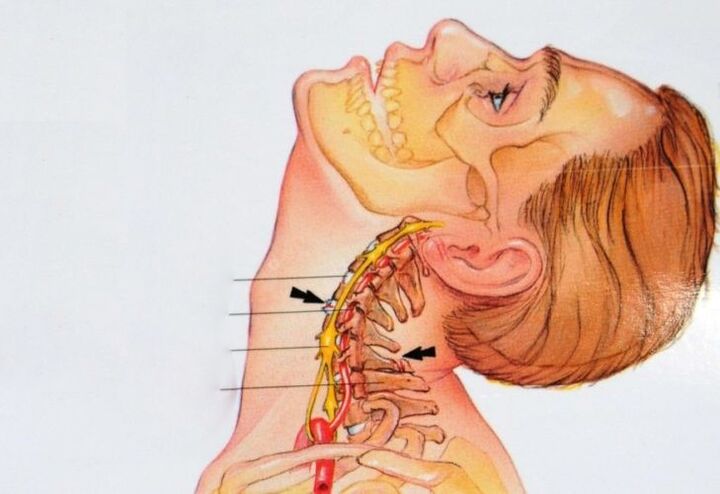Osteochondrosis of the cervical spine is a disease characterized by damage to the intervertebral discs.
Cervical osteochondrosis is one of the most common diseases in the world. Statistically, about 60% of the world's population suffered from it, because modern people suffer from physical inactivity, and also spend a lot of time in sedentary work. Osteochondrosis of the intervertebral cartilageAlong with damage manifests itself in the form of reactive processes in adjacent tissues.
The vertebrae of the cervical spine are much smaller than those of other spinal vertebrae, but the load on them is not reduced. We constantly turn our heads, which is why the neck is in an orderly motion. In the early stages, the disease is recognizedIt is difficult, and the basic manifestations of the disease are often ignored by patients. The result is the onset of cervical collar osteochondrosis, which significantly complicates the further process of treatment.
A modern clinic successfully treats osteochondrosis of the neck by non-surgical methods using correction and kinesiotherapy.

Causes of osteochondrosis of the neck
There are a number of factors that can contribute to the development of osteochondrosis:
- Physical inactivity is the main reason before the development of a dangerous disease. The complete absence of moderate physical activity leads to the degradation of the muscles and bones of the skeleton. Inadequate daily activity is a problem not only for office workers and drivers. People who spend their free timeLikes to be on computer or watching TV, they suffer from hypodynamia.
- Excessive physical activity. Most often, professional athletes who are exposed to axial loads on the back suffer from this. Working out the limits of possibilities puts even novice athletes at risk who train without the supervision of a professional trainerand practice with incorrectly prescribed techniques.
- Negative factors for posture are walking in high heels and uncomfortable shoes, scoliosis, flat feet, as well as improper body position during sleep.
- Excess weight puts excessive load on the spine, causing displacement of the vertebrae and erosion of the cartilaginous structures.
- Gout.
- Disorders of the endocrine system.
- Tension.
- Hypothermia of the neck.
- A sedentary lifestyle (such as drivers and office workers) or excessive physical activity (such as athletes).
As a rule, under the influence of these factors, there is a load on the cervical vertebrae, which causes the formation of muscle spasms. As a result, blood circulation processes are disrupted and metabolism deteriorates, leading to degenerative changes.
An interesting fact: the risk of developing such a disease as osteochondrosis is largely associated with evolutionary changes in the human body. It is about walking upright. During the whole life cycle, the spinal column serves as the "core" of our body. The vertebrae, putting pressure on the cartilaginous discs, gradually wear them out, so the connective tissue degrades. Because of this, osteochondrosis often makes itself felt in old age.
Symptoms and treatment of osteochondrosis of the cervical spine will largely depend on the causes that provoked the onset of the disease. To develop an individualized therapeutic plan, doctors conduct a whole range of examinations. Self-for neck pain. Medication is strongly discouraged. Wrong massages, medications or traditional medical practices can aggravate the condition and lead to a host of irreparable consequences!

Cervical osteochondrosis: symptoms and treatment
The manifestations of a dangerous disease depend on 2 main factors:
- Type of load on the cervical spine.
- The site of damage to the cartilaginous structure of the intervertebral disc.
Nerve roots perform a large number of functions, therefore, the symptoms of damage to their individual parts can be very different. In addition, you need to take into account the stage of development of the disease. There are 4 of them, each of which follows the previous one. is heavier in comparison.
Cervical osteochondrosis 1 degree
This degree is called preclinical and is poorly expressed, which is why patients attribute symptoms to stress, lack of sleep and other seemingly insignificant problems. Spine "destructive" movements and excessive tensionSo people start feeling discomfort.
The main symptoms are:
- Headache
- Neck, shoulder and arms discomfort
- mild visual loss
- Slight decrease in neck motor activity
One of the most noticeable symptoms of the preclinical stage of cervical osteochondrosis is a constant tension of the neck muscles. The muscles quickly overwork, leading to a sensation of tolerable pain, as well as a crunch when turning / tilting the headHappens also.
Since the above problems do not cause much discomfort, most patients prefer to allow the condition to recover. In fact, it is necessary to begin the treatment of osteochondrosis of the cervical spine earlier, because the earlier therapy begins, the more it isThat will be effective.
Cervical osteochondrosis of the second degree
In this case, patients begin to feel pain when tilting / turning the head. Often, uncomfortable sensations spread to the arms, shoulder joints and hands. Problems with the state of the nervous system begin to appear: a person irritable, absent-The brain becomes depleted, its daily working capacity is significantly reduced. The basic symptoms of cervical osteochondrosis in women are almost identical to the symptoms of problems with the reproductive system (weakness, fatigue, depressed mood, and more).
Despite the obvious signs of the development of the disease, it is still possible to get rid of osteochondrosis of the neck. First of all, doctors work to eliminate the risk of hernia, which leads to a deterioration in the mobility of the limbs and blood supply to the brain.
The main symptoms are:
- severe neck pain
- noise in ears
- visual impairment
- Decreased skin sensitivity of the shoulders and arms
- deterioration of tendon reflexes
Cervical osteochondrosis 3rd degree
At this stage of development, the disease is considered to be already neglected. The treatment of stage 3 cervical osteochondrosis is more difficult, since the destruction / deformation of cartilaginous structures is often irreversible. The pain syndrome is becoming stronger, which leads to active herniaAssociated with the growth and friction of the bone tissue of the vertebrae against each other.
In addition to pain, the patient experiences weakness and complains of dizziness. The reason for this is a violation of the large vessels and nerves passing through the spine. The brain receives an insufficient amount of nutrition and oxygen, which leads to clouding of consciousness. Pain radiates to the upper extremities, a feeling of weakness in the arms. Another obvious sign of grade 3 osteochondrosis is loss of sensitivity in the fingers, as well as tingling in them.
The main symptoms are:
- increased pain
- hernia of the cervical spine
- very weak tendon reflexes
- paralysis of upper limbs
Cervical osteochondrosis grade 4
Cartilaginous tissue of the intervertebral discs has already undergone major changes due to destruction. In stage 4 of the disease, protrusions and hernias occur in 99% of cases, which have a significant negative effect on the patient's condition. The body heals independentlybegins and "builds up" of tissue in areas of disc damage. As a result, the column itself loses its mobility.
As nerves and blood vessels are constricted, the person loses coordination of movements. Drowsiness, somnolence and pain only intensify. Patients often complain of annoying tinnitus. In addition, in stage 4 of cervical osteochondrosis followingThere is a risk of having several consequences:
- The risk of developing cerebral ischemia, spinal stroke. This is due to the strong compression of the vertebral arteries.
- Impaired perception of the surrounding world and systematic loss of consciousness. The reason for this is the pinching of blood vessels and insufficient blood supply to the cerebral cortex.
- Fatal outcome. A disastrous outcome can occur as a result of spinal cord stiffness.
The main symptoms are:
- depression of brain activity
- lack of understanding
- increased dizziness
- paralysis
- hearing and vision loss
- angina pectoris, shortness of breath
How to treat cervical osteochondrosis: clinical stages
Before starting to eliminate the disease, the doctor conducts a comprehensive examination of the patient's cervical spine. This is necessary in order to establish the fact of the presence and neglect of the disease. Diagnosis consists of several stages:
- X-ray. This is a visual method of determining the location of the vertebrae, as well as changes in their mobility.
- Laboratory research. With the help of tests, doctors establish disorders of the spinal column, and also make a final diagnosis.
- CT. It is a modern technique for assessing ruptures and changes in the height of the intervertebral discs. In addition, computed tomography helps to track the instability of individual vertebrae.
- MRI. The presented stage of the examination is performed to determine the condition of the nerve roots, the quality of blood circulation, as well as pathological changes in cartilaginous / bone structures.
- Differential diagnosis. This includes ultrasound scans, cardiograms and many other procedures. They are necessary in order not to confuse osteochondrosis with other diseases that have similar symptoms. These include diseases of the urinary system, all kinds of deformities of the spinal column, hip injuries, as well as disorders of the central nervous system.
Determination and treatment of symptoms of cervical osteochondrosis is impossible without a comprehensive diagnosis. The sooner this is done, the more effective the therapy will be. If you find symptoms of the disease, visit your doctor as soon as possible. He is of narrow profile. Will give referral for appointments with specialists: a neurologist and an orthopedist. In some cases, it may be necessary to consult a cardiologist if the symptoms of the disease overlap with suspected angina pectoris or ischemia of the heart muscle.

In modern clinics, the diagnosis and successful treatment of osteochondrosis of the neck is carried out based on the use of kinesitherapy. With the help of this treatment technique, patients, performing a set of physical exercises on special exercise machines for recovery, significantly improve their health. improvement occurs.
Basic methods of treatment of cervical osteochondrosis in women and men
A high-quality and stable result in the treatment of osteochondrosis of the cervical spine can be achieved only with an integrated approach to the problem. The effectiveness of recovery largely depends on the patient's mood, which can be determined by lifestyle, diet, sleep. And Jagran has to be completely revised.
It is by no means possible to independently treat osteochondrosis of the cervical spine in women and men, since the basic symptoms of the disease may indicate the development of a completely different disease. Drugs chosen without the knowledge of the doctor will aggravate the condition. Even the primary intake of painkillers does not always have the expected effect, which once again proves the need for prior consultation with a specialist.
alleviation of pain
The disease often manifests itself as a stabbing, aching and pulling pain syndrome. The main task of the doctor is to ease your suffering, therefore, first of all, experts recommend:
- anti-inflammatory drugs;
- vitamins;
- Painkiller;
- Chondroprotectors.
The last class of drugs is aimed at restoring cartilaginous structures, which is especially important in advanced stages of the disease. Additionally, patients are given drugs to relieve muscle spasms and improve blood flow to the body. Huh.
therapeutic gymnastic exercises
Specialists in physical therapy know how to get rid of cervical osteochondrosis in the most economical ways. Exercise therapy is one of the most effective ways to treat osteochondrosis, which can also be used at home. The intensity of exercise in this case is no matter. Does not play a role. Regularity of moderate physical activity will help to achieve results. Here is the effect of exercise:
- Strengthening the muscles in the neck, which are responsible for supporting weak vertebrae.
- Stimulation and normalization of blood supply in the body, which is especially important for the cerebral cortex.
- Increase in general tone, charge of energy, restoration of productivity and working capacity of a person.
Exercise therapy classes are allowed on a daily basis. The set of exercises includes all kinds of head rotations and tilts. With an appropriate level of physical fitness, the level of difficulty increases and hand movements are associated with the work. TherapeuticThe advantage of gymnastic elements is that they can be used even in the workplace. But remember that they can be performed only after the acute pain syndrome is over.
As an additional load, doctors recommend that patients go to the pool, as swimming relieves stress on the spine and relieves tension from the intervertebral discs. Shown with light dumbbells to strengthen the shoulder girdle andWork done.
physical treatment
There are several methods of physiotherapy:
- electrophoresis.
- Magneto, laser and shock wave therapy.
- Mud therapy.
- Medicinal baths and showers.
The above are only the main therapeutic methods aimed at restoring blood supply to the affected spine, eliminating swelling, pain, and slowing the process of fracture of the neck.
massage
Treatment of cervical osteochondrosis of the spine with massage is widespread throughout the world. But this method should be used very carefully, since rough and unqualified impact on the damaged parts of the neck can make the condition worse. massagersBefore making an appointment with D. , you should consult with your doctor.
Thanks to the effect of the hands on the sore area, muscle tone decreases, thereby relieving painful spasms. It also improves blood circulation, restores clarity of thought and general well-being of the patient.
Surgery
Severe intervertebral hernias are formed in the late stages of the development of the disease, as well as a narrowing of the lumen of the spine. Surgical intervention may be required to treat the patient in this case. The surgeon decides that the operation is necessary. Whether or not. He also determines the complex of preparatory measures, the period of postoperative recovery and rehabilitation.
Most surgical interventions involve removal of the resulting hernia as well as replacement of the damaged vertebrae.
Treatment of cervical osteochondrosis in the clinic
Treatment of osteochondrosis of the cervical spine in a professional clinic involves the use of exclusively non-surgical methods. Specialists work according to a unique technique developed on the basis of the principles of kinesitherapy. Patients who come to us for help. The treatment is carried out in specially equipped rooms with a set of physical exercises.
Treatment of cervical osteochondrosis occurs according to an individually developed program. Therapeutic effect is not only on a specific part of the spinal column, but also on the internal organs. Drug-free and non-surgical treatment process is difficultBut we do provide comprehensive support to patients, helping them become more decisive and rethink their approach to their disease.
This healing process is made from:
- Training in the rehabilitation room at least 2-3 times a week.
- Partere Therapeutic Gymnastics.
- Thermotherapy according to individual indications.
- Ice massage provides relief from pain.
- Therapeutic/restorative massage.
- Adaptive exercise for work at home.
- Micro-anatomical study of ultrasound to track recovery over time.
- Individual consultation with specialists from the Kinesitherapy Clinic.

prevention of osteochondrosis
The treatment of osteochondrosis of the cervical spine in the context of modern medicine includes many effective methods. But it is better not to let this problem appear at all, than to deal with its elimination. A set of preventive measures is a set of measures that the presence of a dangerous disease. and will reduce the risk of developing:
- Take a hot bath for 10 minutes daily. A systematic visit to the bath/sauna is also recommended. Please note that these recommendations are only suitable for people who do not have any cardiovascular health problems.
- Go for a swim and take regular walks in the fresh air at a leisurely pace. Physical inactivity is one of the main causes of diseases of the musculoskeletal system.
- Refuse excessive physical exertion at the limit of human capabilities. This is especially true when working out in the gym. Severe axial load on the spine leads to protrusion.
- Try to avoid stabbing in the back, especially if you are over the age of 30.
- Review your diet. Try to exclude the intake of confectionery, flour, moderate salt and sugar. Reducing the calorie content of foods allows you to avoid gaining excess weight, which puts additional pressure on the spinal column.
- If you work in an office and spend a lot of time at the computer, consider buying a special lumbar and neck support chair. Try to do basic warm-up exercises every 60 minutes.
- In the event that pain appears after waking up, consider purchasing an orthopedic mattress and pillow. If possible, get a bed with a flat, hard surface.
- To avoid degenerative and dystrophic changes in the cervical spine, visit a professional massage therapist at least 2-3 times a year. Neck and collar massage is one of the most effective preventive measures.
- Women should minimize walking on high heels, as this interferes with the natural position of the spine. With diagnosed flat feet, it is recommended to purchase special shoes or insoles, as orthopedic products correct the position of the foot. and relieves unnecessary tension from the spinal column.
As well as:
- you should shower regularly
- You have to give up bodybuilding, which can contribute to the protrusion of the cervical disc
- Gentle exercise may be a good prevention of disease
result
Treatment of osteochondrosis in a professional clinic takes place under the strict supervision of highly qualified specialists. Doctors follow an integrated approach in working with patients and even deal with advanced stages of the disease. If you notice the symptoms of osteochondrosis. If you notice, you don't need to go to the doctor, self-medicate and delay. Start your journey to a healthy, happy life!



















































